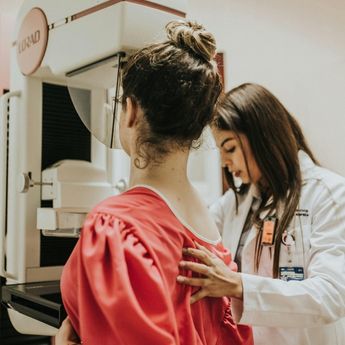by Catarina Martins from Willkin
Exercise has numerous benefits for individuals with breast cancer. These include a reduction in the severity of side effects of treatment, improved physical and mental health, and an overall sense of improved wellness. In addition, appropriate exercise is safe and plays a key part of care for lymphedema. Lymphedema is an abnormal swelling of the arms, hands, breast, or torso and generally occurs when the lymph node or lymphatic vessels are removed or damaged. Encouraging muscle movement and breathing techniques, during exercise, allows to stimulate the lymphatic system and helps improve lymph flow. Tailored exercise guidelines for cancer survivors have been developed and implemented worldwide. These guidelines recommend aiming for 20 to 60 minutes of aerobic exercise two to three times per week, along with resistance training of all major muscle groups twice a week, with an emphasis on cancer-specific considerations and safety precautions.
With the COVID-19 pandemic, many breast cancer patients have experienced reduced access to exercise facilities as well as limited options for in-person training options. Aside from the pandemic situation, sometimes it is difficult to access in-person exercise programs due to distance, cost, remote/rural home locations, and other logistical factors.
So, how can patients exercise safely both during and after treatments, and how can the recommended guidelines for exercise be achieved, in the face of such barriers?
Luckily, modern-day technology has allowed for greater choice and increased options for accessing virtual care and exercise. Many reputable exercise and rehabilitation programs have adapted their offerings to respond to the growing need and popularity of virtual programming. Live-stream and pre-recorded classes may be offered to patients so that they can safely participate in fitness programs in the comfort of their own homes. Telerehabilitation is also another cost-effective method for reducing some of the barriers to exercise, as exercise prescription could be explained over the phone when video is not an option. Telephone health coaching can be very helpful in engaging patients, providing them the support they need to stay motivated and complete their prescribed exercise sessions.
In the initial stages of an exercise program for breast cancer patients, there should be a focus on restoring and improving mental and physical well-being. The effects of cancer treatment are wide ranging, individualized, and may progress in severity with each stage of treatment. Breast cancer-related lymphedema may occur following breast cancer treatment. Thus, it is important that exercise programs are designed to accommodate individual health needs, tailored to an individual’s functional abilities and progressed in a gradual way. Trained exercise professionals can prescribe home-based exercise and monitor individuals as if they were in-person. Whether it is via live videoconferencing or telerehabilitation, these professionals will help with adherence to an exercise program, bearing in mind the recommended physical activity guidelines for breast cancer patients. With expert guidance, it is entirely possible to achieve these exercise recommendations, virtually, in a safe and fun way.
There are many advantages to participating in a virtual exercise program. It may be less costly without the expense of driving to and from a physical exercise facility, including the cost of gas and potentially parking. Not having to travel to an in-person program will also cut down on time for someone with a busy schedule. With pre-recorded exercise classes, it affords you the flexibility of accessing the class at any time of your choosing. It is also a benefit to exercise in the comfort of your own home on snowy or rainy days, avoiding potentially risky travel when the weather conditions are unfavourable. For those suffering from significant cancer-related fatigue, it is helpful to be able to reduce the physical effort in getting ready for, and travelling to, an exercise session or class. For breast cancer patients who may be immune-compromised, it is of major benefit to exercise at home as there becomes a reduced risk of infection spread by others.
Insofar as social isolation being a concern, this can be mitigated by joining a live virtual class consisting of other breast cancer patients. Even though you are not in the same physical location, you can still experience a sense of comradery, accountability and motivation with others in the virtual group. On the other hand, for those who do not like the idea of exercising in a large group class within a busy fitness facility, virtual classes are an excellent way of building your confidence in a more private environment. And as an unrelated side benefit, you might even find yourself an exercise partner in a family member living with you, who wouldn’t normally have attended an in-person exercise class or fitness facility.
Willkin offers the “Living Life Beyond Cancer” program (priced at $600 plus tax). Supervised by an accredited Kinesiologist and supported by scientific research, it is adapted for any type of cancer and through all stages of rehabilitation. The goal of the program is to help maintain health and fitness during treatment and beyond, while improving overall quality of life. The 12-week program is divided into four phases and is individualized. Health and medical status are assessed at each phase. This program is offered in-person and virtually and consists of exercise and education to help you through all stages of your cancer journey.
References:
Keeping Patients With Cancer Exercising in the Age of COVID-19
Photo by SHVETS production from Pexels







